
Occitan, also known as lenga d'òc by its native speakers, and sometimes also referred to as Provençal, is a Romance language spoken in Southern France, Monaco, Italy's Occitan Valleys, as well as Spain's Val d'Aran in Catalonia; collectively, these regions are sometimes referred to as Occitania. It is also spoken in Calabria in a linguistic enclave of Cosenza area. Some include Catalan in Occitan, as the distance between this language and some Occitan dialects is similar to the distance between different Occitan dialects. Catalan was considered a dialect of Occitan until the end of the 19th century and still today remains its closest relative.

Aquitaine, archaic Guyenne or Guienne, is a historical region of southwestern France and a former administrative region of the country. Since 1 January 2016 it has been part of the region of Nouvelle-Aquitaine. It is situated in the southwest corner of Metropolitan France, along the Atlantic Ocean and the Pyrenees mountain range on the border with Spain, and for most of its written history Bordeaux has been a vital port and administrative center. It is composed of the five departments of Dordogne, Lot-et-Garonne, Pyrénées-Atlantiques, Landes and Gironde. Gallia Aquitania was established by the Romans in ancient times and in the Middle Ages, Aquitaine was a kingdom and a duchy, whose boundaries fluctuated considerably.

Poitou-Charentes was an administrative region on the southwest coast of France. It is part of the new region Nouvelle-Aquitaine. It comprised four departments: Charente, Charente-Maritime, Deux-Sèvres and Vienne. It included the historical provinces of Angoumois, Aunis, Saintonge and Poitou.

The Gallo-Romance branch of the Romance languages includes in the narrowest sense the langues d'oïl and Franco-Provençal. However, other definitions are far broader and variously encompass the Occitan or Occitano-Romance, Gallo-Italic or Rhaeto-Romance languages.
Old French was the language spoken in most of the northern half of France approximately between the 8th and the 14th century. Rather than a unified language, Old French was a linkage of Romance dialects, mutually intelligible yet diverse. These dialects came to be collectively known as the langue d'oïl, contrasting with the langue d'oc in the south of France.

Of the languages of France, French is the sole official language according to the second article of the French Constitution. French, a Gallo-Romance language, is spoken by nearly the entire population of France.
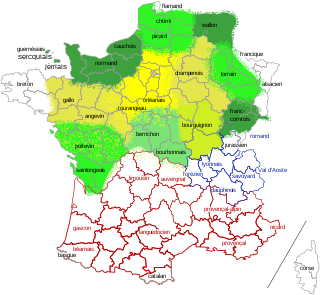
Picard is a langue d'oïl of the Romance language family spoken in the northernmost of France and parts of Hainaut province in Belgium. Administratively, this area is divided between the French Hauts-de-France region and the Belgian Wallonia along the border between both countries due to its traditional core being the districts of Tournai and Mons.
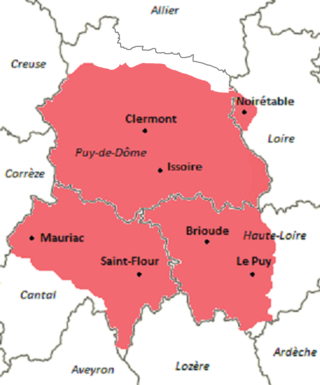
Auvergnat or Occitan auvergnat is a northern dialect of Occitan spoken in central and southern France, in particular in the former administrative region of Auvergne.

The langues d'oïl are a dialect continuum that includes standard French and its closest autochthonous relatives historically spoken in the northern half of France, southern Belgium, and the Channel Islands. They belong to the larger category of Gallo-Romance languages, which also include the historical languages of east-central France and western Switzerland, southern France, portions of northern Italy, the Val d'Aran in Spain, and under certain acceptations those of Catalonia.

Gallo is a regional language of eastern Brittany. It is one of the langues d'oïl, a Romance sub-family that includes French. Today it is spoken only by a minority of the population, as the standard form of French now predominates in this area.
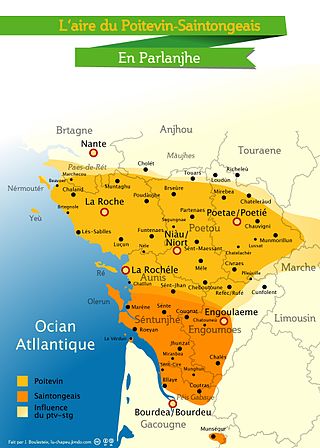
Poitevin-Saintongeais is a langue d'oïl language spoken in the regions of the Pays de la Loire and Nouvelle-Aquitaine, officially recognised by the French Ministry of Culture as a language with two dialects, Poitevin and Saintongeais. This classification is a subgroup of the Romance, and the Gallo-Romance languages.
Quebec French is different in pronunciation and vocabulary to the French of Europe and that of France's Second Empire colonies in Africa and Asia.

Occitania is the historical region in Western and Southern Europe where the Occitan language was historically spoken and where it is occasionally used as a second language. This cultural area roughly encompasses much of the southern third of France as well as part of Spain, Monaco, and parts of Italy.

Berrichon is an Oïl language very closely related to French or a dialect of it traditionally spoken in the historical area of the French province of Berry. The word is also used as a demonym and as an adjective meaning "pertaining to Berry".
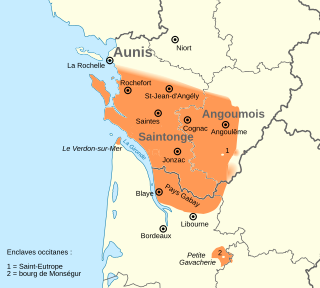
Saintongeais (saintonjhais) is a dialect of Poitevin-Santongeais spoken halfway down the western coast of France in the former provinces of Saintonge, Aunis and Angoumois, all of which have been incorporated into the current departments of Charente and Charente-Maritime as well as in parts of the neighbouring department of Gironde and a town in Dordogne. Although many of the same words are used in both Charente departments, they differ in what they mean or in how they are pronounced.

The Croissant is a linguistic transitional zone between the Langue d'oc dialects and the Langue d'oïl dialects, situated in the centre of France where Occitan dialects are spoken that have transitional traits toward French. The name derives from the contours of the zone that resemble a croissant, or crescent.
The Bourbonnais dialects are spoken in the historic region of Bourbonnais, located in central France and including the department of Allier the area surrounding Saint-Amand-Montrond, in southeastern Cher. This linguistic zone is located between those home to the languages of Oïl, Occitan, and Franco-Provençal.
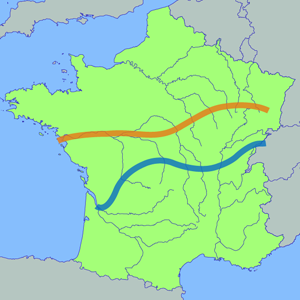
The von Wartburg line is the name commonly given to a language border highlighted by Walther von Wartburg in his 1939 study, Die Entstehung der romanischen Völker. This line enables a distinction between the northern and southern varieties of Gallo-Romance languages in the 9th century. It was identified for the first time by Jakob Jud.

The French Great South-West is a geographical, sociological, economic and cultural entity bringing together the administrative regions of Nouvelle-Aquitaine and Occitanie, resulting from the merger on January 1, 2016, of five previous regions; in these two regions combined, it covers 156,000 km2, or 29% of the territory of metropolitan France. It is a grouping devoid of its own political or administrative structures, set up, with the objective of an interregional reflection on spatial planning at the level of new European issues, at the initiative of the Interministerial Delegation at territory planning and regional attractiveness.
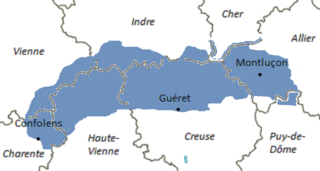
Marchois or Marchese is a transitional Occitan dialect between the Occitan language and the Oïl languages spoken in the historical region of La Marche, in northern Limousin and its region. Occitan and Oïl dialects meet there,.

















